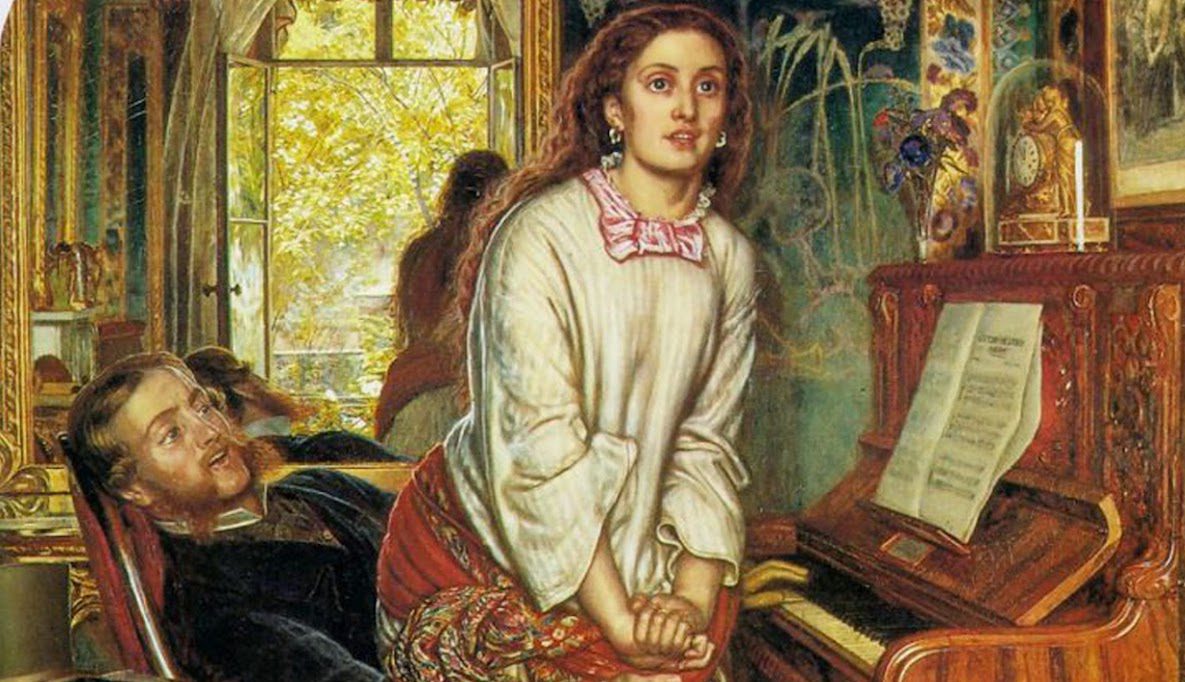Reflections: Van Eyck & The Pre-Raphaelites: In a way, it’s a bit of surprise to find the Pre-Raphs, even some of the grander ones, on view at the National Gallery. Their natural home seems to be Tate Britain. The NG does, of course, show some British art, or quasi-British. You don’t go there to look at Turner, an artist of world reputation by any standard of measurement. You do expect to see work by those honorary Brits, Holbein and Van Dyck. And there is, of course, the Wilton Diptych, with its elegant portrait of Richard II. This, however, despite its subject, is catalogued as ‘English or French?’ The note of doubt signals the fact that art historians don’t really believe that an English artist would, at this epoch, have been capable of producing anything quite so elegant and sophisticated.
‘Those naughty Pre-Raphaelites shamelessly appropriated too’ – ELS
The NG show doesn’t make any very ambitious claims for the Pre-Raphaelite Movement in general. What it does demonstrate is that the British 19th-century impulse to wards certain kinds revivalism in art was something that was European in scope, not by any means confined to British artists. In Europe the equivalents of the Pre-Raphaelites, and just marginally their predecessors, were the German Nazarenes of the very early 19th century, who took themselves off to Italy the learn the secrets of Italian 15th-century art.

As Wikipedia tells one: ‘In Rome, the group lived a semi-monastic existence, as a way of re-creating the nature of the medieval artist’s workshop. Religious subjects dominated their output, and two major commissions allowed them to attempt a revival of the medieval art of fresco painting.’
The NG exhibition nevertheless takes as its starting point, not anything Italian, nor fresco painting, but a long-celebrated panel by Jan Van Eyck painted in 1434, and purchased for the National Gallery in 1842, just over four centuries later. The Pre-Raphaelite Brotherhood was founded in 1848, just six years after this.
As its name signals, the Brotherhood did indeed present itself as a reaction against specifically Italian traditions. Raphael and the other Italian High Renaissance masters. It embarked, so the members wanted to tell their audience, on a path that led, away from the Baroque, and versions of plodding 19th-century Realism, towards a new vision for art. But this vision let them, not to Giotto, but to Northern Europe.
The paradox offered by the NG show is that much of this retrograde impulse came, in practical, specific terms, not from the Italians, as the name Pre-Raphaelite might suggest, but from a study of the Flemish artists of the 15th century, and from Van Eyck in particular.
Pre-Raphaelitism was, though retrograde, also a recognisably avant-garde movement, long before the term ‘avant-garde’ had been invented. Its members lifted two fingers and waved them derisively at the art establishment of its time. ‘To put things right,’ they cried, ‘let us return to an honest simplicity of vision that has in our time been forgotten.’ Avant-gardes since then have often embraced similar tactics. One can look, for example, at the inspiration Gauguin found in the South Seas, and at the suggestions the Cubists took from tribal African art.
The exhibition offers a further insight, by focusing our attention very specifically on the convex mirror that can be seen in the very centre of Van Eyck’s painting, right below his elaborate signature. Similar mirrors can be seen in a number of the Pre-Raphaelite paintings included in the show, and, to drive the point home, there are actual convex mirrors included as well – fashionable items of 19th century home furnishing. To drive the point home, the show itself is entitled Reflections.
I think the point being made here is that the reflection in any mirror of this sort is a lie. It was rather appositely made again in one of the highest priced exhibits the recent Frieze art fair – a Jeff Koons copy of a composition by Giotto, with a shiny blue glass ball planted in front of it.
At every epoch, artists have borrowed from what has gone before them. The process has now been canonised with the pompously fashionable term ‘appropriation’. Why should we be shocked to discover that those naughty Pre-Raphaelites shamelessly appropriated too?
And why should we be shocked, still further, to find that the fashionable mirrors artists set up offer us and the world images subtly different from the reality we expect to find in them?
Jonathon Jones recently gave this exhibition at the NG a one-star review in The Guardian. All one can say is ‘Cheer up, dear – the fact is that the show rather cleverly demonstrates that the Pre-Raphs were more certainly up to the minute than you are.’
Reflections: Van Eyck & The Pre-Raphaelites National Gallery London Until 02 April 2018

